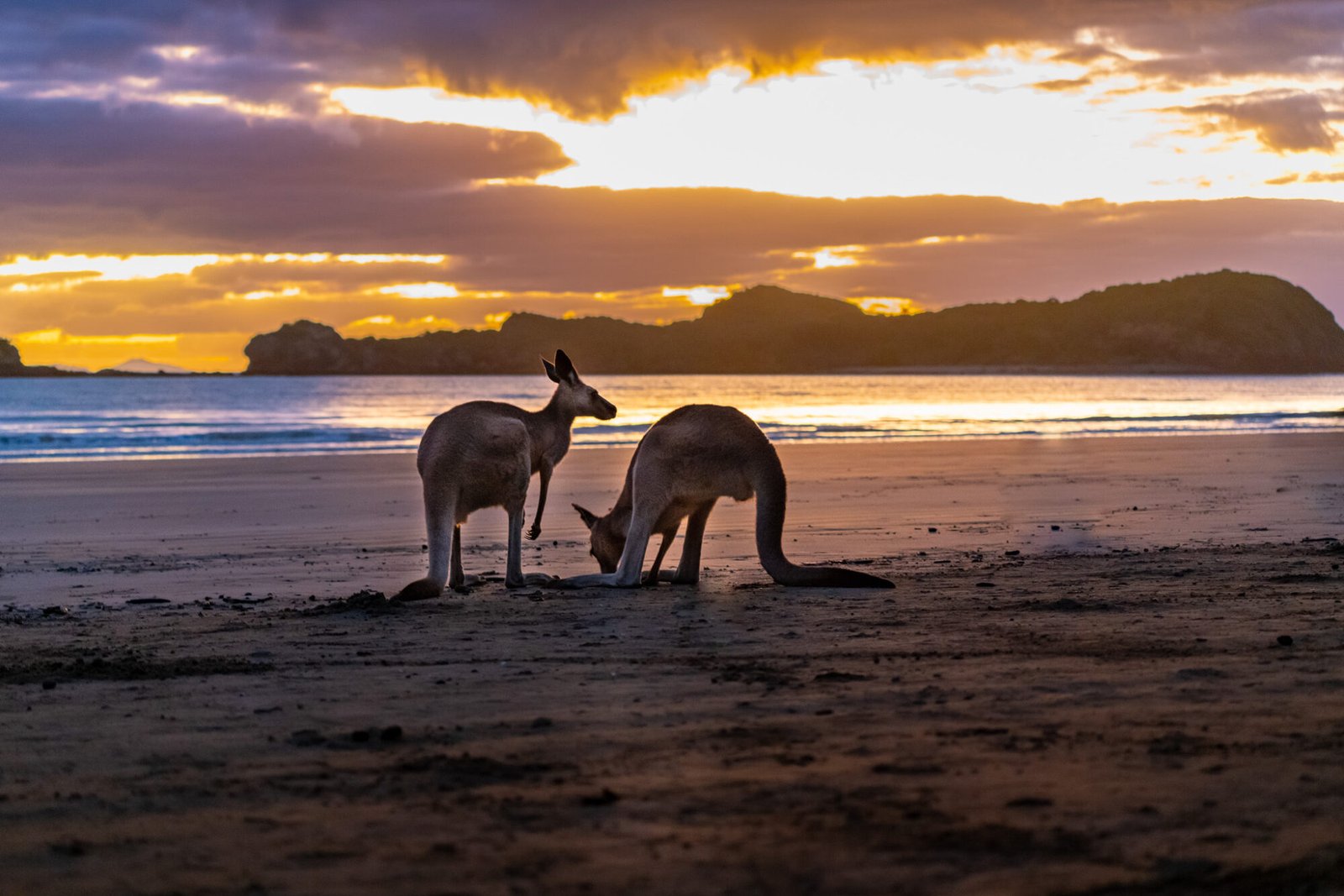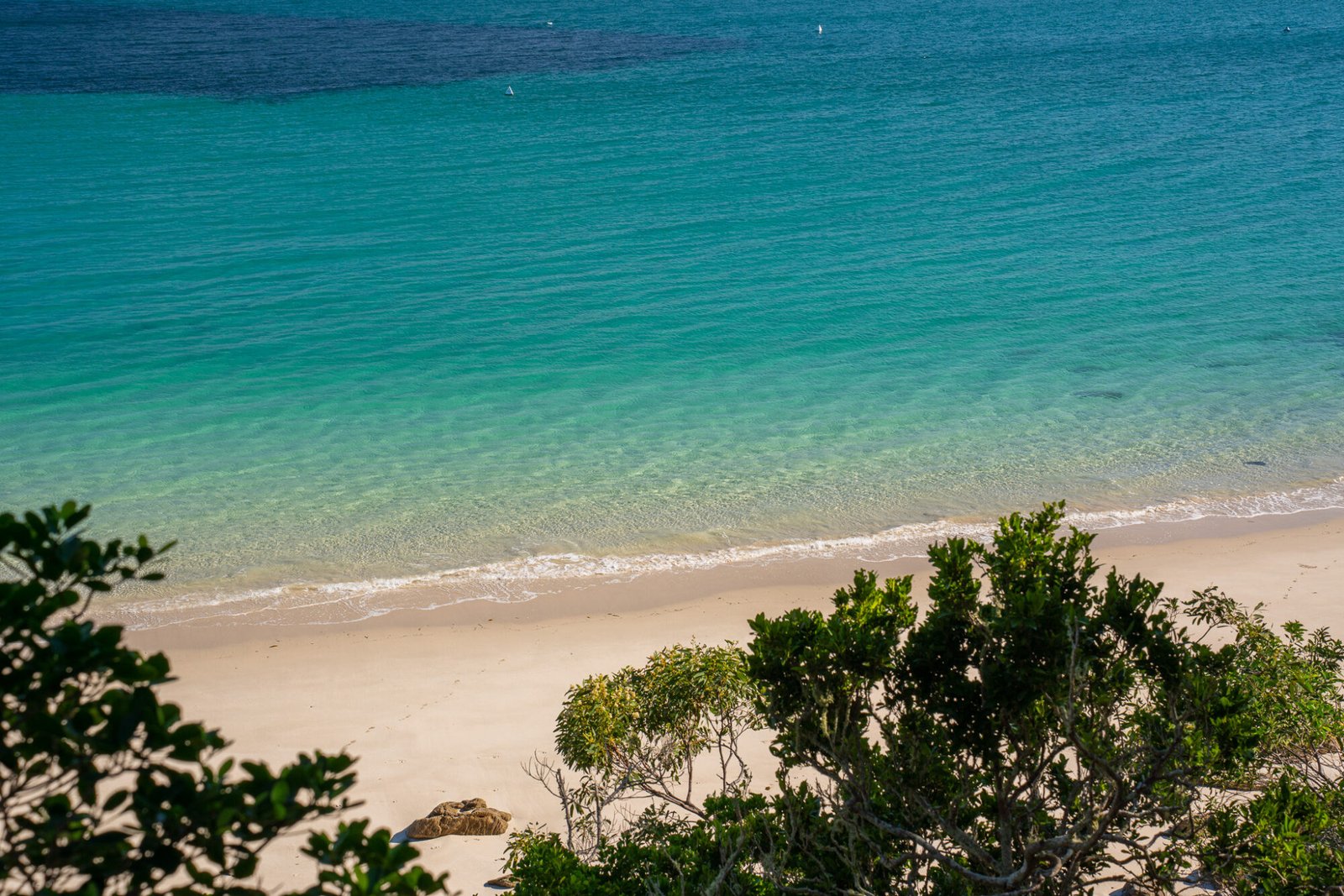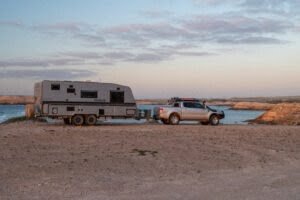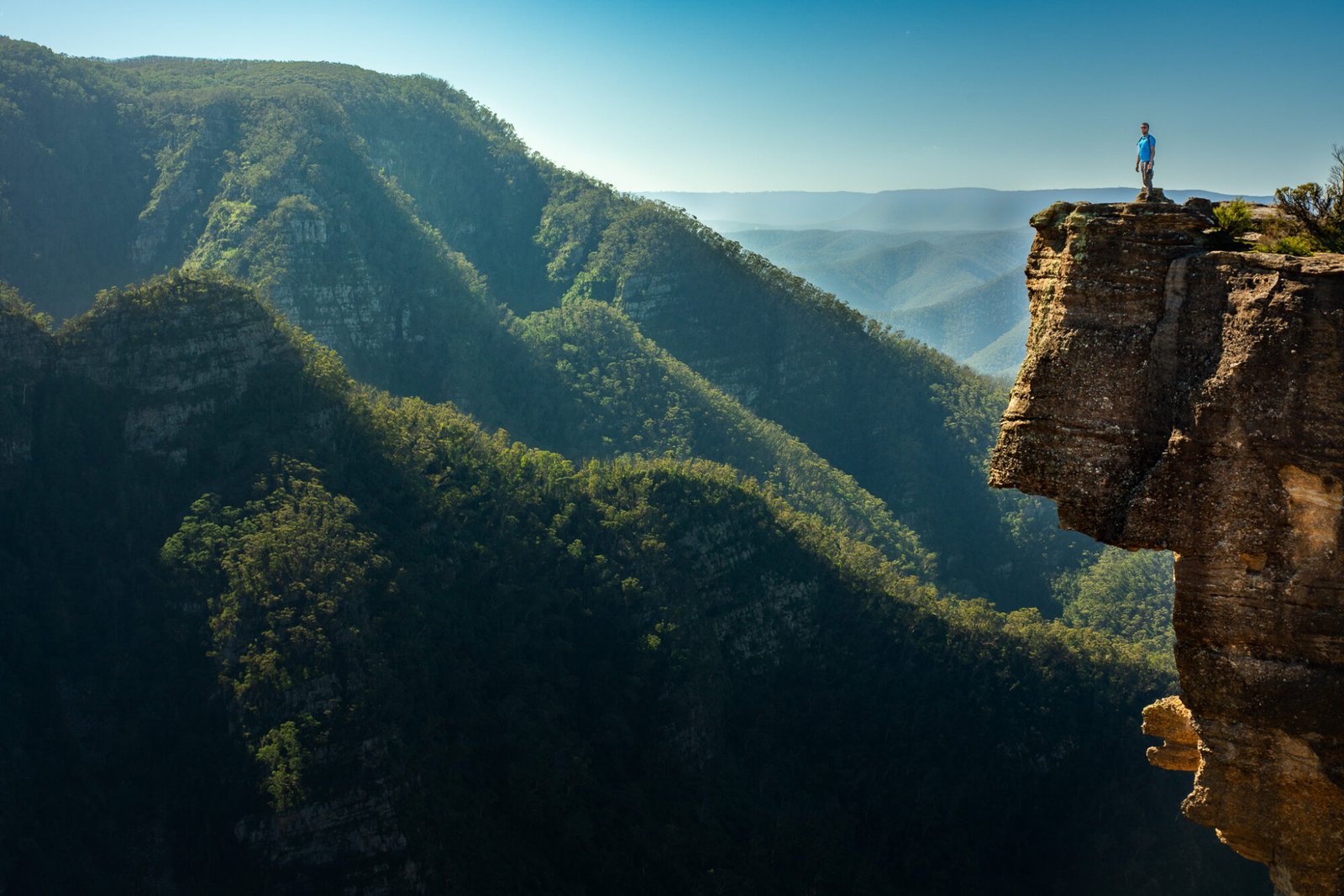TRAVEL DURING COVID TIMES
During the first 18 months or so of living with the Covid epidemic, we were incredibly lucky that state lockdowns and border restrictions did not overly affect our travel plans. We had had a relatively lax regional lockdown in Perth for 9 weeks and a 5-day lockdown in Darwin. Otherwise, it was pretty much life as usual for us. It seems we already have a fairly socially distanced lifestyle! This all changed when we planned to travel from Darwin to Tasmania. We had so many obstacles to overcome, we weren’t sure we were going to make it to Tasmania at all!
We originally planned to travel through Outback Queensland and New South Wales to Melbourne to catch up with friends and family before taking the ferry to Tasmania. However, as lockdowns continued to get stricter, especially in New South Wales and Victoria, we realised a few months before our trip that we couldn’t take that route anymore. So instead, we decided we would go straight down the centre of Australia, then across to Melbourne and the ferry terminal from South Australia. What could go wrong?
MATARANKA AND BITTER SPRINGS
After about 3.5 months in Darwin, we said our goodbyes and made our way south to Elsey National Park. Elsey National Park, located about an hour south of Katherine, is most known for its thermal pools, Mataranka and Bitter Springs. These pools are extremely popular during the winter months but can still be enjoyable when it’s warmer out as the pools aren’t overly hot. We went to Mataranka Springs first, the more popular of the two.
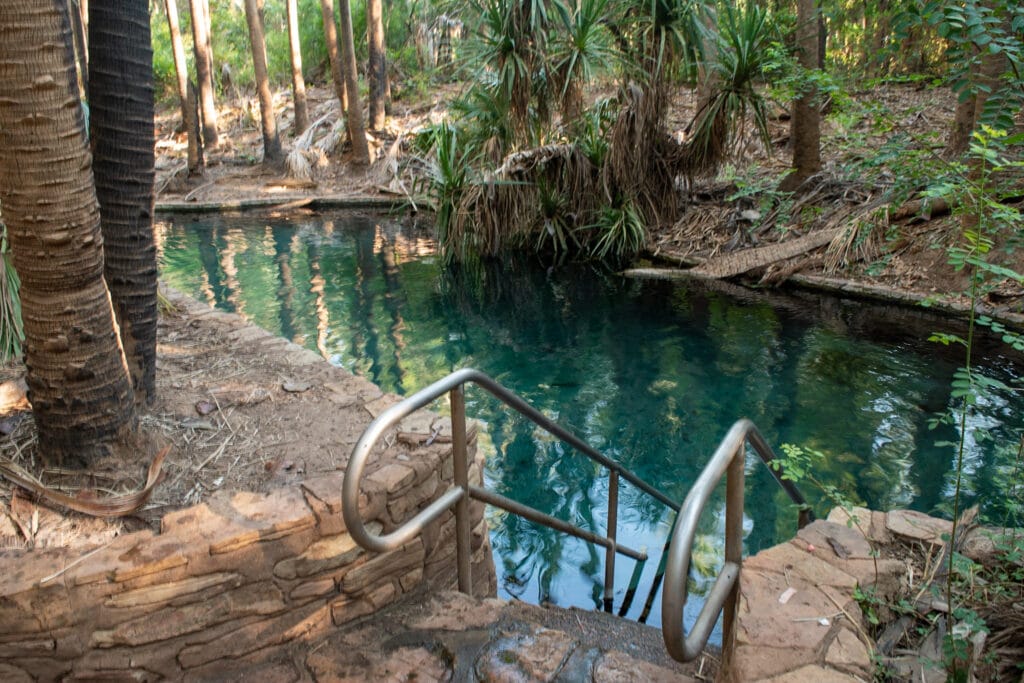
A short boardwalk stroll through a forest of tall palm trees takes you to a beautiful clear pool that is so inviting except for one thing: the bats! There are bats EVERYWHERE here. It didn’t stop us from taking a dip and enjoying it, but we still tried to avoid putting our heads under.
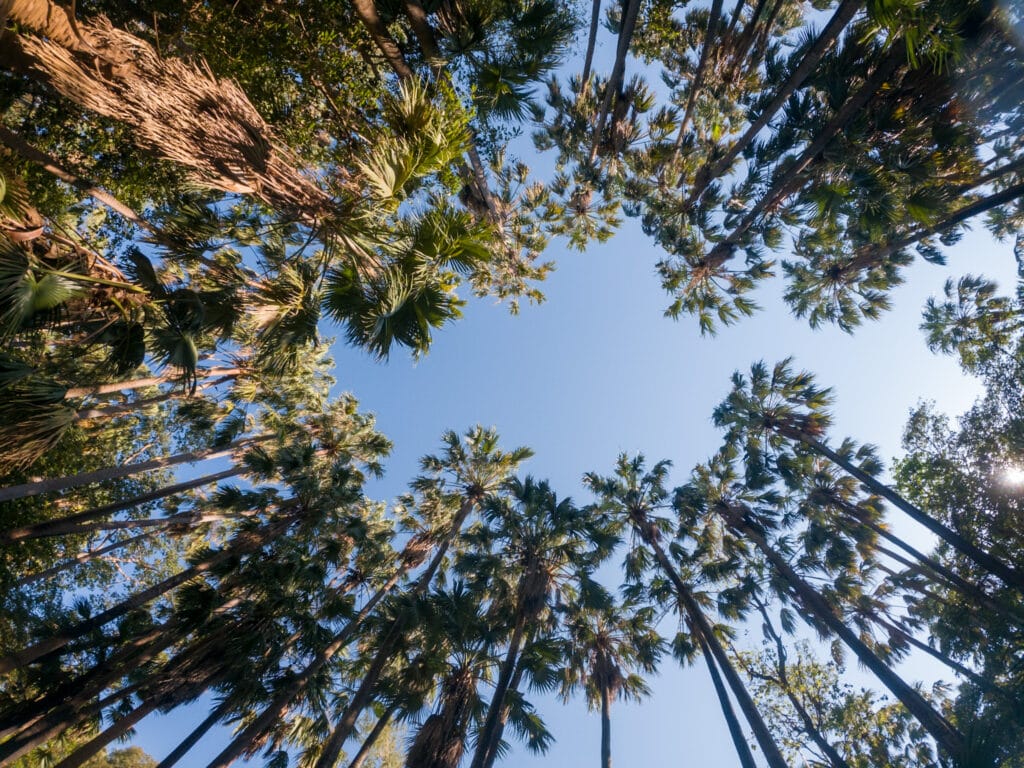
The following day we did the short, easy hike along the Roper River to Mataranka Falls (really more of a cascade but still lovely).

We followed that with a visit to Bitter Springs, the more natural-looking and usually less busy pool. It has the same clear, warm water as Mataranka Springs, but the fun part of this one is entering the springs upstream and leisurely floating along with the current. So don’t forget your floatie!
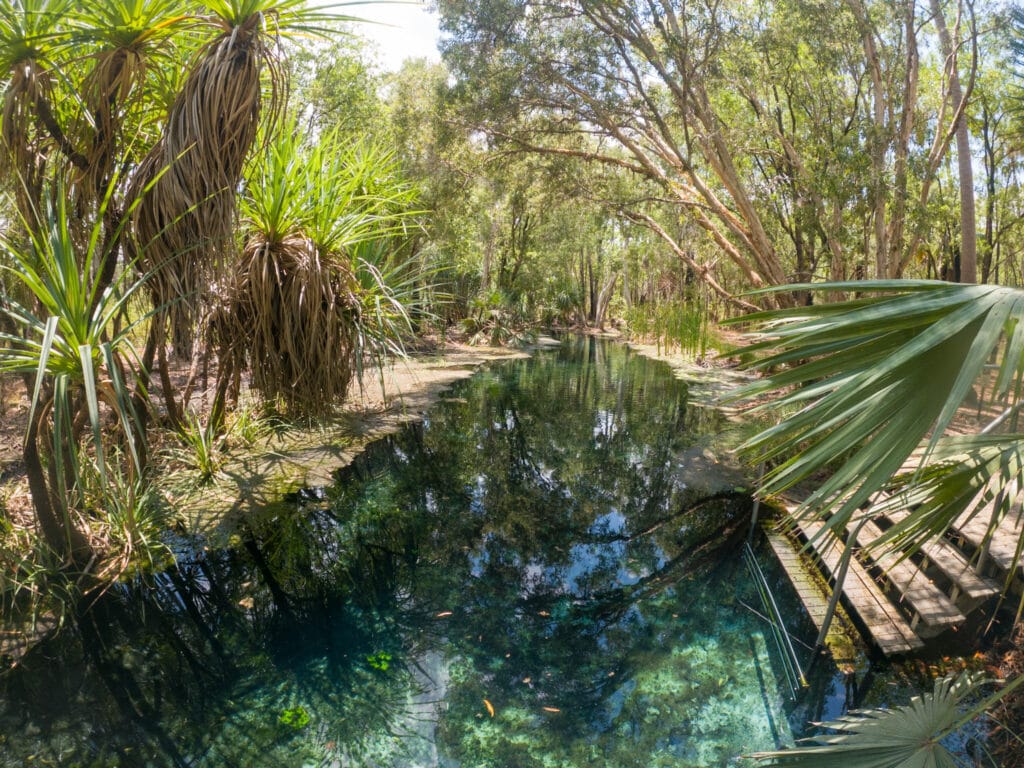
We appreciated having these temperate pools to enjoy as it was quite hot during our visit in October. One morning around 10 a.m., our barbecue registered a temperature of 150 Celsius without being turned on!
We also tried fishing along the Roper River, which if you know anything about us I’m sure you can guess how successful (or not) we were. It is very important to be croc-wise in this area as the Roper River is a known estuarine crocodile habitat. In 2023, Bitter Springs was shut temporarily due to a croc sighting.
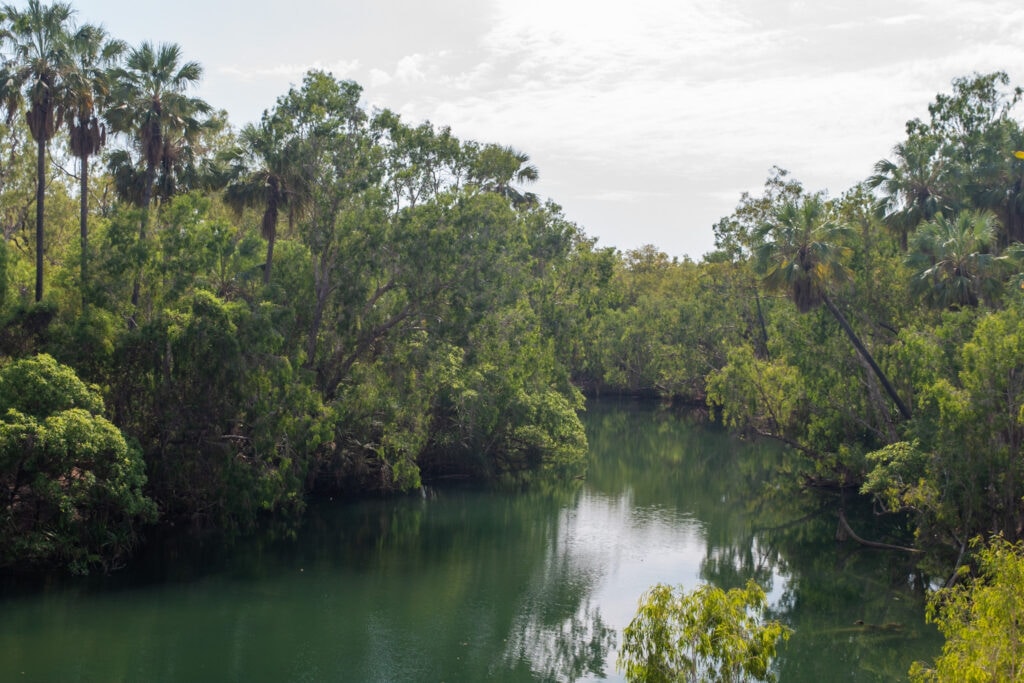
DALY WATERS PUB
For our next destination, we continued another couple of hours south to one of Australia’s iconic pubs: Daly Waters Pub. Daly Waters Pub promises Outback hospitality, ice cold beer, and the unique decor that typifies the classic Australian pub.

During peak times this place can be absolutely heaving with people, with live acts or musicians on offer most nights, but otherwise it’s a pretty relaxed atmosphere. Normally there are a few farm animals wandering around; however, during our visit the donkey had just had a foal and wasn’t up for a pub visit. The pub also offers affordable and convenient camping out back, and a pool which is a welcomed sight during the warmer months.
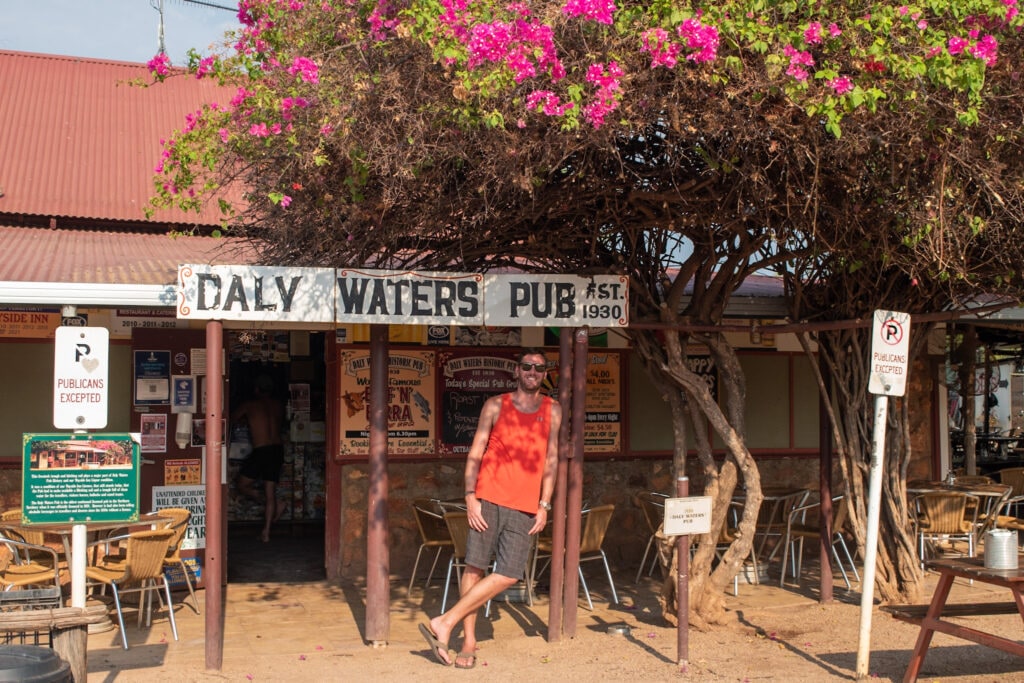
IYTWELEPENTY/DAVENPORT RANGES NATIONAL PARK
Our next destination after Daly Waters was Devils Marbles, which at our usual easy-going towing pace took us a couple days to get to. We saw Karlu Karlu/Devils Marbles a couple years prior during our last visit to Central Australia, so we had a quick look around before ending up at the Devils Marbles Hotel.
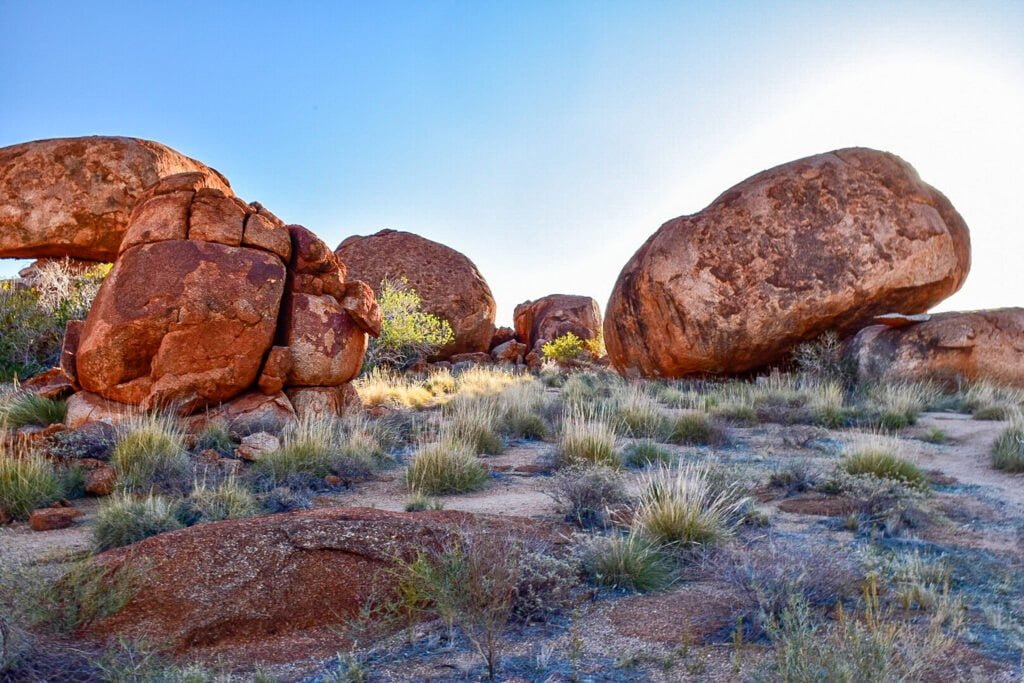
We cannot recommend this caravan park highly enough! The grounds are nothing special, but it feels like an oasis in the middle of the desert. The pool is refreshing, the beer is cold, and the staff are friendly and accomodating.

They even let us leave our van there for a few days at no cost (probably due to it being low season) while we went to Iytwelepenty/ Davenport Ranges National Park, a park we missed out on last time we were in the area. This park is where the borders of the traditional lands of the Warumungu, Alyawarr and Kaytetye meet; it also has signs of European settler history still dotted around the park. It’s great for four-wheel-driving and perfect for enjoying a bit of solitude among a classic Central Australian landscape.
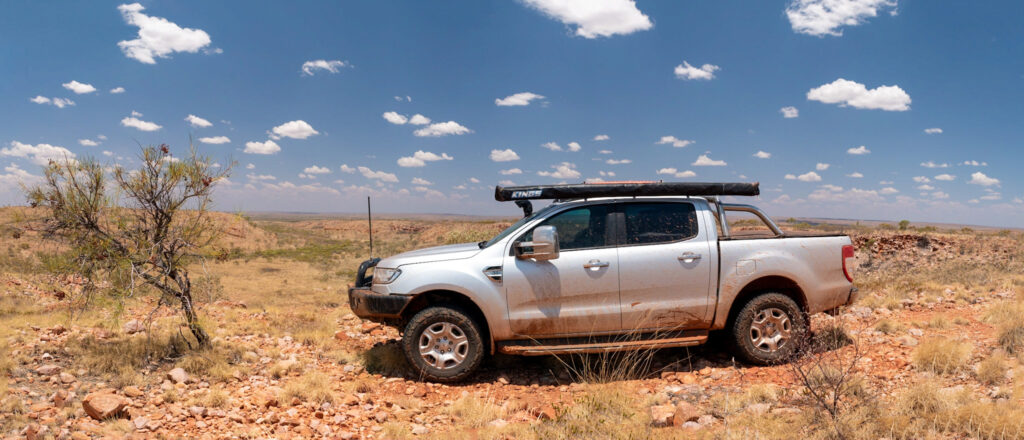
We set up camp at Old Police Station Waterhole, which luckily for us still had plenty of water to cool down in. It’s such a large swimming hole, you can (and we did) even swim laps in it!
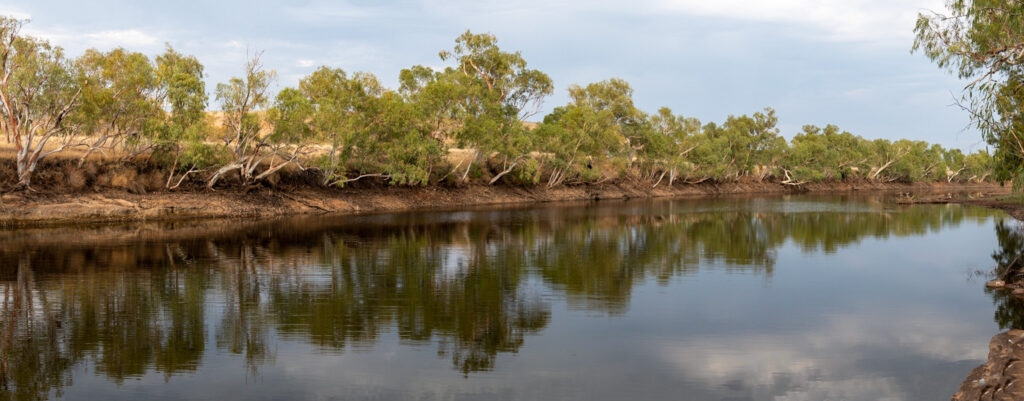
There’s also a nearby, easy walk through the ruins to learn of the history of the area.
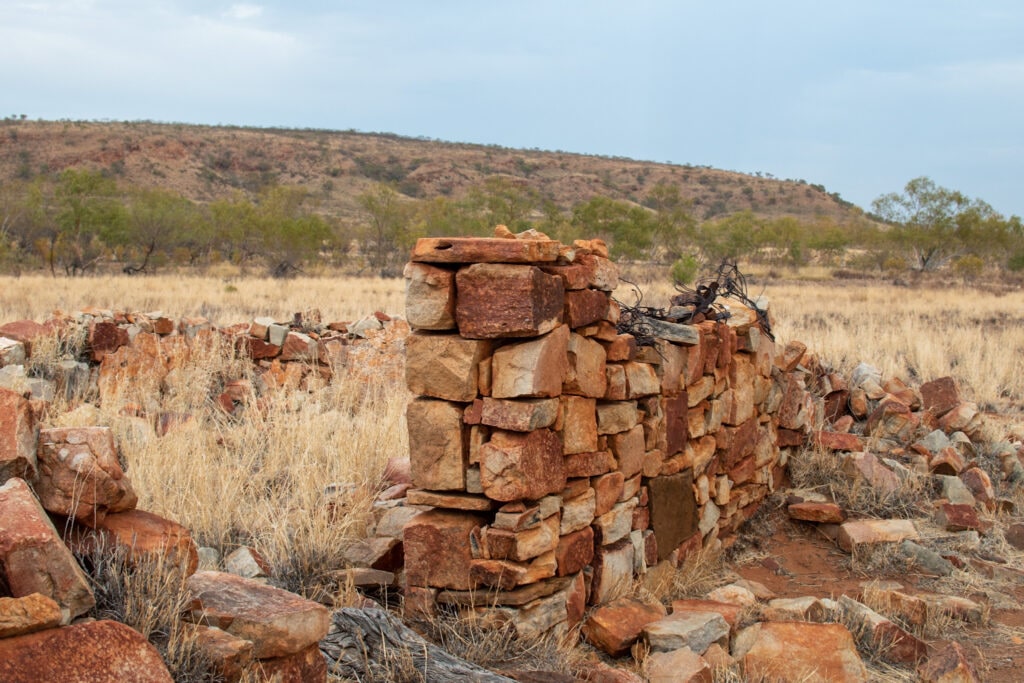
Depending on your level of expertise and preparation, there are plenty of opportunities for four-wheel-driving. As this tends to be a less visited park, the road conditions can vary greatly; contact NT Parks beforehand for an up-to-date road report. Also be aware that storms can occur, usually during the summer months. Even in October a massive storm hit us one night, to the point where we weren’t sure if us or our tent would survive the night (luckily, it did — phew!)
ALICE SPRINGS AND ULUṞU
After a couple peaceful days in Davenport Ranges (minus the big storm), we went back to Devils Marble Hotel, picked up our van and continued on to Alice Springs. We had a big goal we hoped to achieve during our time here: to see Uluṟu in the rain. You may be wondering, “Wouldn’t you rather have good weather for a visit to Uluṟu?” And the answer to that is, “It depends.” Of course, Uluṟu on a clear day, changing colours as the sun hits it at different angles, is nothing short of magical.
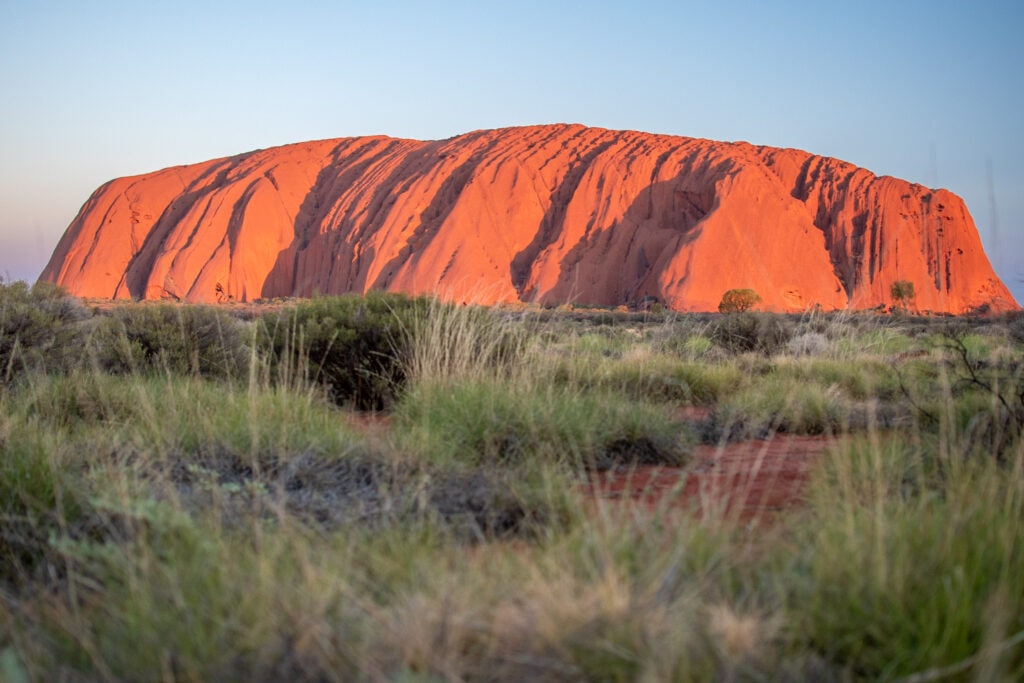
However, another spectacular experience is to be at Uluṟu in the wet, when waterfalls stream down around the Rock. It is so unique and unlikely that only 1% of visitors will experience this phenomenon. Having already seen Uluru in good weather, we were hoping we could get the chance to see it in the rain this time around.
We didn’t get off to a good start with accomplishing this goal, as we missed a massive dump of rain over Uluṟu by one day. However, we had high hopes as the forecast showed more rain in a few days time. After a night’s stay in Erldunda, we left our van at the roadhouse so we could travel quicker, packed up the tent, and made our way to Yulara. The next day, overcast skies held some promise for us.

Unfortunately our dream of seeing Uluru in the rain was not meant to be (at least not this time around!) as the light rain quickly dissipated and the dark clouds continued their path over the horizon. Nevertheless, our visit to Uluru and Kata Tjuṯa wasn’t all for naught; we still enjoyed a couple magical days there before returning to our van and continuing to South Australia.

BEING CHASED BY COVID
On our way back from Yulara, we got some very unwanted news; the town of Katherine reported cases of Covid in the community. The incident was well after our time there and our chances of having Covid were minuscule. Nevertheless, the entire state of Northern Territory was subject to restrictions when crossing the border. Leaving Erldunda, we struggled to get updated information on the go in Central Outback Australia.
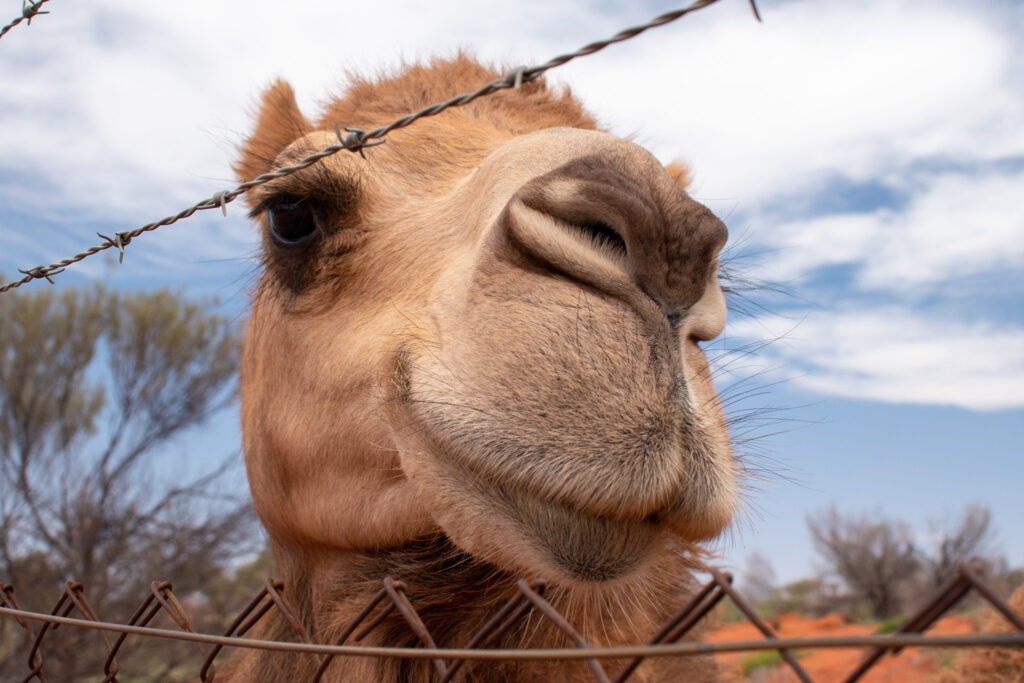
Eventually we worked out that once in South Australia, we would need to get Covid tests on our first day, fourth day, and seventh day of travel. The trouble with that was, the first checkpoint from the NT-SA border was 160km away in Marla, and the first town available for testing was Port Augusta, another almost 800km away! Luckily the officers at the Marla checkpoint were very understanding and told us just to get tested as soon as we could. And thankfully, all our tests returned negative.
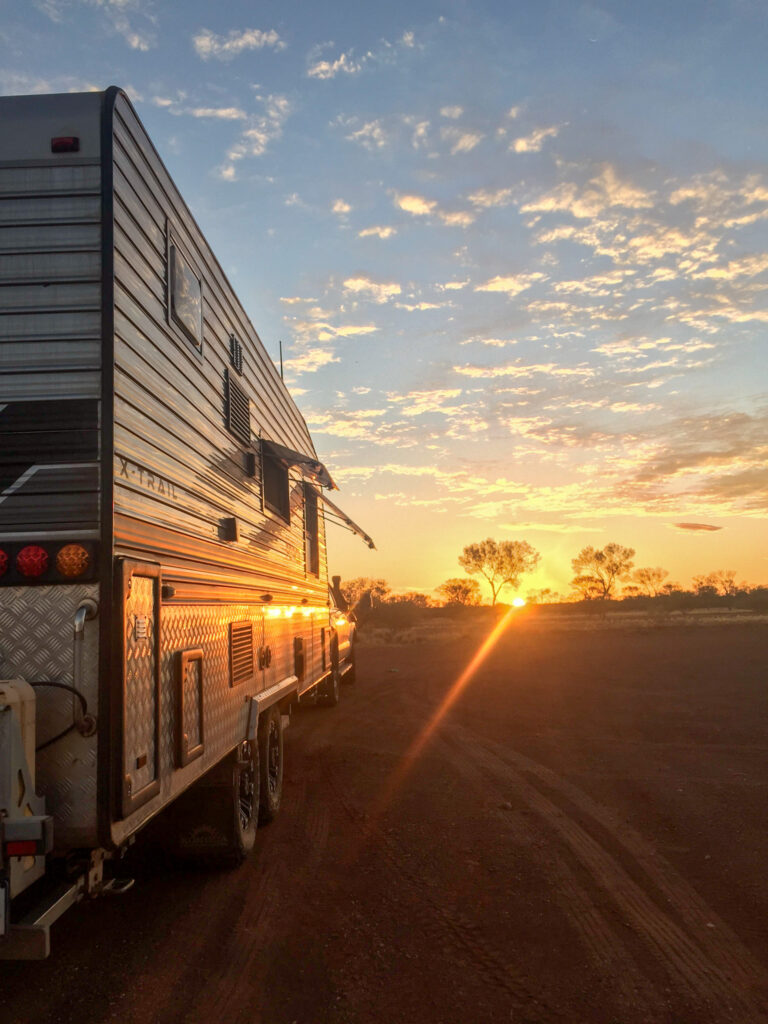
ADELAIDE HILLS
Once we got the all-clear from our Covid tests, we made our way to one of the last of the well-known South Australian wine regions for us to visit: the Adelaide Hills.
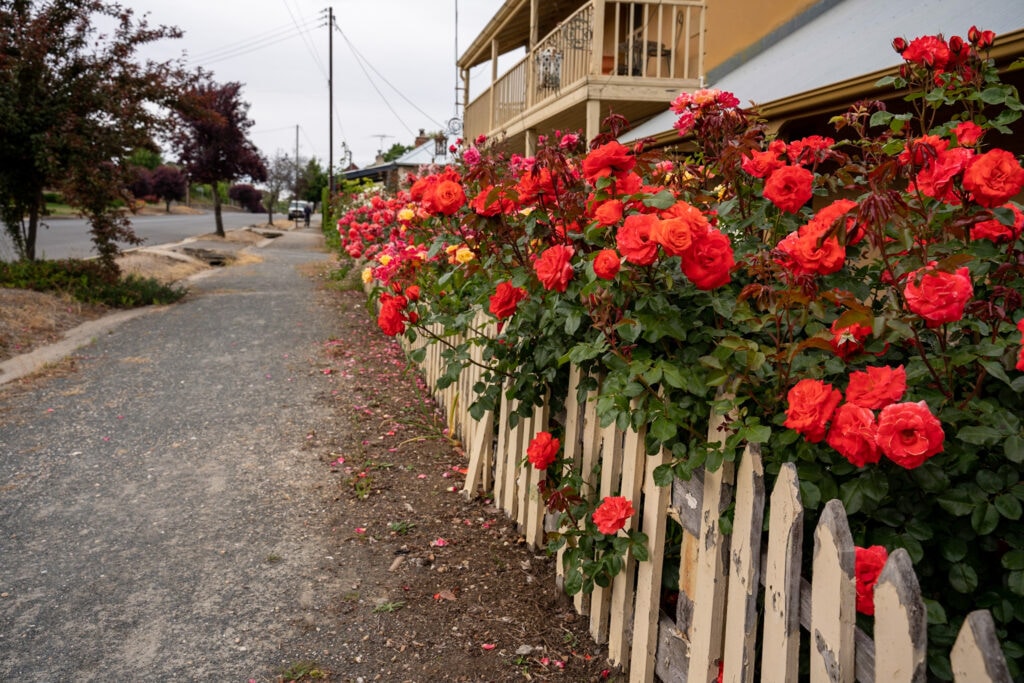
We parked up out the back of a delightfully cozy pub in Mt Torrens (which unfortunately does not seem to be taking caravans anymore) and headed over to two wineries recommended to us: Shaw+Smith and Golding Wines. Golding was definitely the favourite of the two!
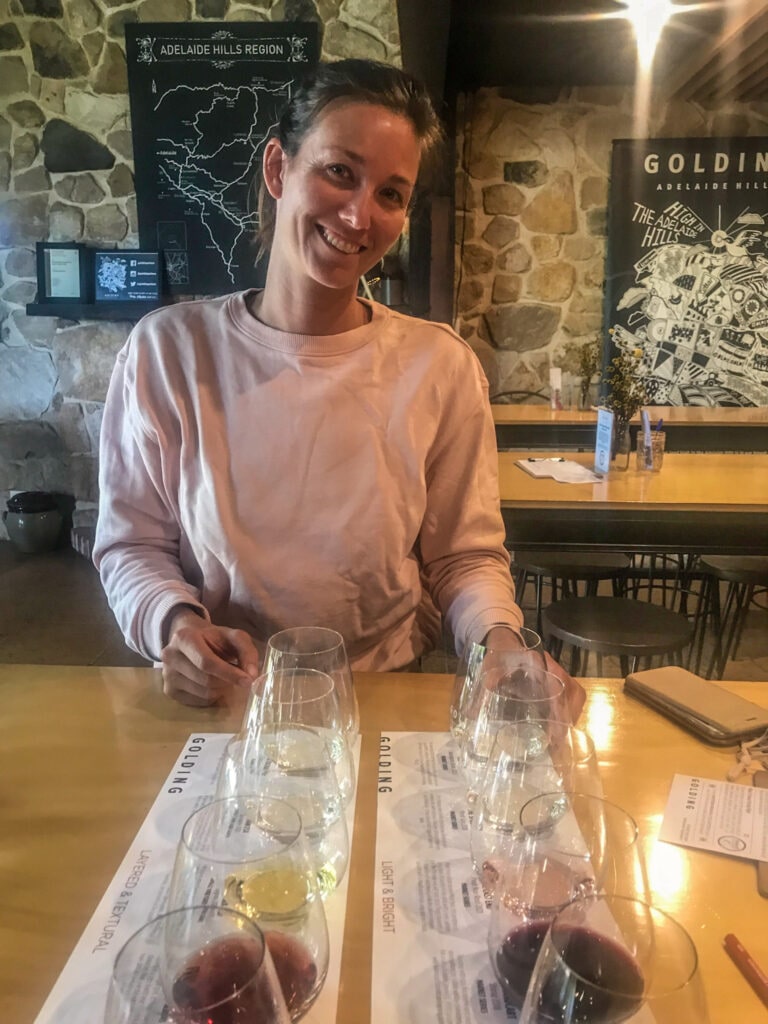
We also paid a visit to the German-themed town of Hahndorf and the Beerenberg Farm, which allows strawberry picking most days from November to April.
BORDERTOWN AND THE DASH TO THE SPIRIT OF TASMANIA
Our last stop before catching the ferry to Tasmania was Bordertown. Due to Covid restrictions, we could still transit through Victoria to get to the ferry terminal in Melbourne, but on a couple conditions: 1) we had 24 hours after entry to get to the terminal, and 2) we could stop only for fuel. Bordertown was one of the closest towns on the SA-VIC border that we hadn’t been to yet, so we chose to stay there while getting ourselves ready for our trip to Tasmania. We stayed at a fantastic wildlife sanctuary for injured animals, Safe Haven Wildlife Sanctuary.
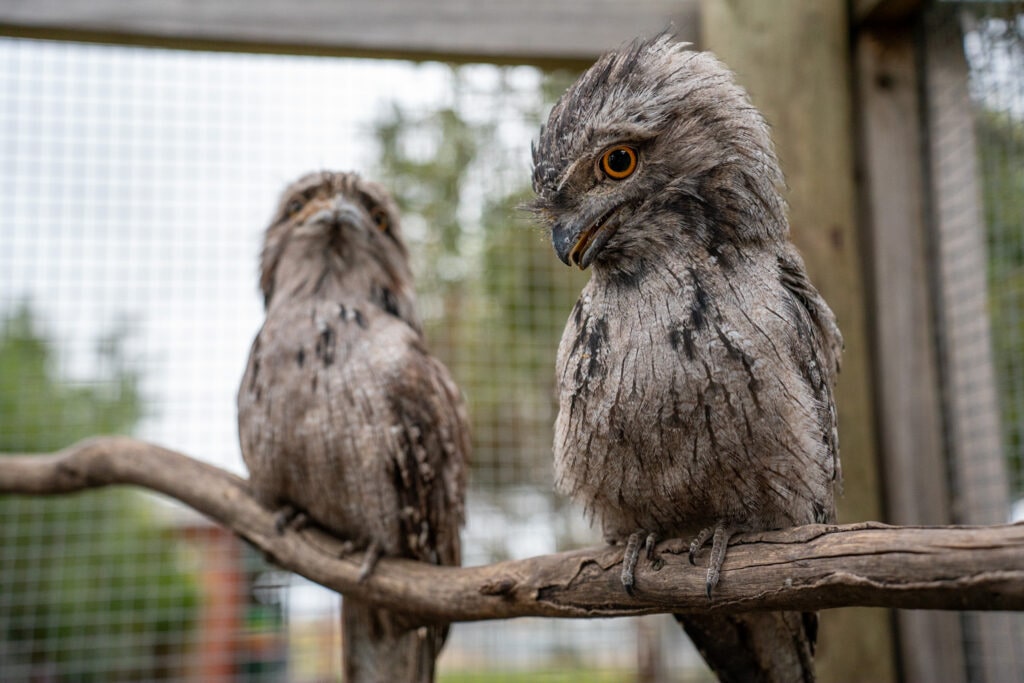
They were more than happy to show us around the property to meet some of the animals, including wallabies, wombats, tawny frogmouths, and more! At the time the sanctuary allowed a small number of self-contained caravans to stay on the property on a donation basis, but unfortunately, as of August 2023 they are not currently taking campers. Nevertheless, the town itself has a wildlife park with native animals, including some unique white kangaroos.
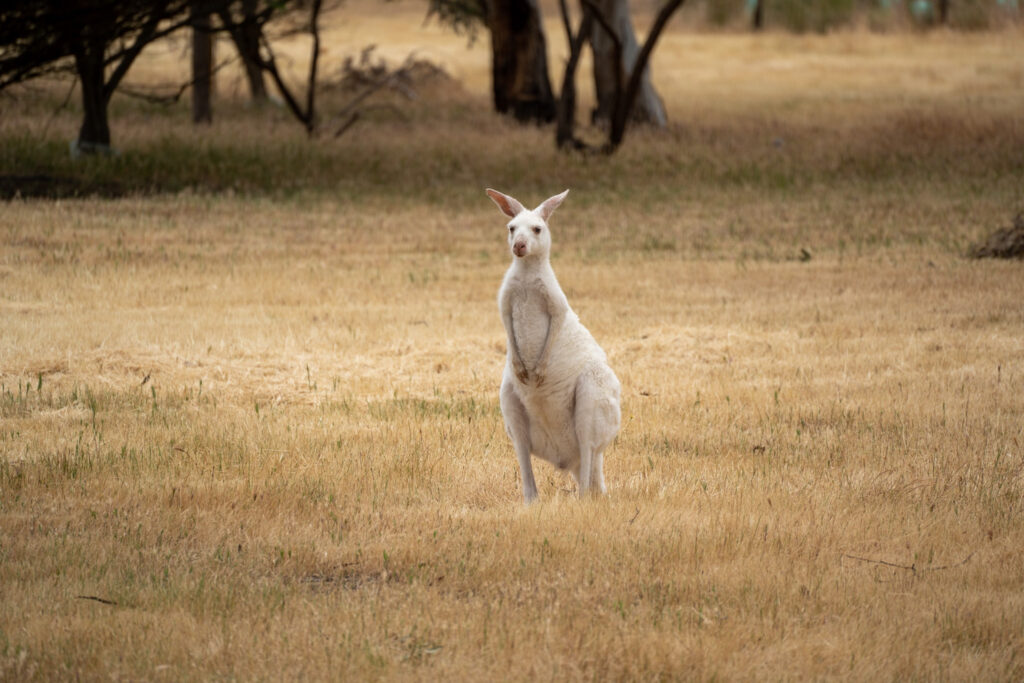
The day of our ferry sailing, we got going early to start the trip to the Spirit of Tasmania ferry terminal, which was still in Port Melbourne at that time. We wanted to allow as much time as possible to account for any possible mishaps, such as a flat tyre, that might happen along the way. Overall, the trip went smoothly and we arrived with plenty of time to spare. We waited in our car until boarding time and then found our way to our room for the night. We felt the exhaustion of the stress of the trip down from Darwin but also the excitement of what was to come. Against all odds, we were going to Tasmania!

